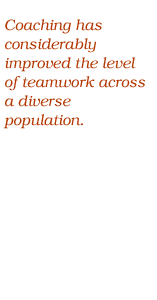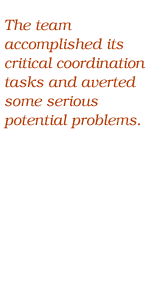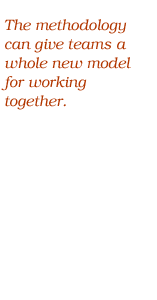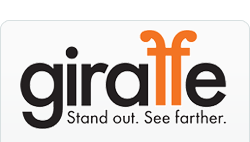Team learning for managers |
Senior change team |
Innovation: pushing the limits |
Barry Callebaut AG
Team learning for a global managers' conferenceSituation:
In 2004, this global manufacturing company had brought together its top 100 managers for the first time. The meeting was a success for networking and learning about the company, but what more could managers take away from a 3-day annual conference…and more important, what more could they bring to it?
Challenge:
How could the company increase the ROI of their managers' conference? What structure and focus did the meeting need to elevate it from a social event to a meaningful problem solving and learning process?
Solution:
The CEO chooses a major theme for each year's conference (e.g. competition, innovation, etc.). Over the three months preceding the meeting, small teams of managers work across disciplines and regions to investigate a specific problem. During the teamwork period, we coach teams through project milestones, and then at the conference we facilitate brainstorming and other activities as teams perfect their presentations. The senior management team judges the best proposals in a competitive event. All proposals are then recorded and distributed for follow-up action.
Result:
Beyond the value of networking and renewing relationships, the meetings have solved real business problems. New ideas have gained recognition. New corporate resources (e.g. a competitor database) have been established. And managers have learned from the experience of trying new models for cross-functional teamwork.
"Our annual Managers' Conference has grown to become a big success – for networking senior colleagues across regions and disciplines, and for thinking together to solve real business problems. Jerry Murphy's guidance and coaching of these teams of managers has greatly improved the quality of the outcome."
Patrick De Maeseneire, CEO, Barry Callebaut AG

Northeastern University
Facilitating a senior change management forumSituation:
We were already working on an engagement with NU to provide communications support for a new academic calendar. During this project, we proposed a parallel engagement to the senior leadership: to convene a senior team to coordinate the change process from a higher altitude, on behalf of the student – the university's key customer.
Challenge:
An informal survey of stakeholders from across the university revealed a clear need for more strategic information about how multiple pieces of the change process would fit together. The situation called for collaborative senior attention.
Solution:
We facilitated weekly meetings of a 15-member "Student Experience Team" over a critical 4-month period to assure that the change process was harmonized. All members, including two SVPs and the Provost, participated as an active team, not as representatives of constituent groups.
Result:
By the final meeting, the team had accomplished its critical tasks and averted some serious potential problems. Northeastern successfully converted its full-time academic programs from a quarterly to a semester calendar that September.

Various clients
Pushing the limits for new ideasSituation:
Managers and teams are increasingly asked to "be innovative." However, without a supportive culture and specific tools, real innovation can be a difficult goal.
Challenge:
With expectations high but not defined, managers and teams in all kinds of organizations are often left to their own devices to find ways to become more innovative. In many companies, innovation is institutionalized in a specific department such as product development or marketing. This can create a "civilian" class in the rest of the company, and can ignore a great potential source of ideas.
Solution:
We have successfully applied an immersive brainstorming methodology (based on the Deep Dive™, originally developed by IDEO) to a wide variety of teams and situations. In contrast to random "brainstorming," the immersive method imposes a structure that yields a far better success rate. Done properly, it is rigorously time-based, bound by specific design constraints, and employs divergent/convergent rounds of thinking and feedback to quickly produce a prototype solution.
Result:
The immersive technique produces a rich stream of potential solutions, and gives teams a whole new model for working together. Long-term, teams become more creative, less bureaucratic, and more prepared to collaborate to solve problems. The "focused chaos" of these sessions is a lot more fun than meetings, too.
Deep Dive™ is a trademark of Deloitte Consulting.


